#st. hubert hound
Explore tagged Tumblr posts
Text

today's daily is: the talbot dog! (canis familiaris)
( requested by @dogmans-posts :] )
#extinct daily#talbot dog#st hubert hound#st. hubert hound#canis familiaris#art#drawing#paleoart#dog art#dog drawing#dog#animal art#falls over#back officially . ough hello
37 notes
·
View notes
Text
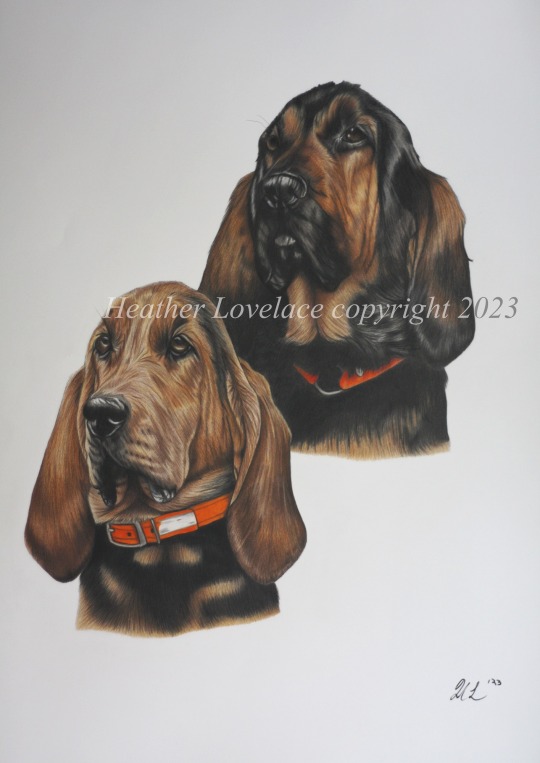
A commissioned memorial portrait of Bloodhounds Dio(top) and Jewel(bottom). Polychromos and Luminance colored pencils used on 18"X24" Strathmore paper.
#bloodhounds#chiendesthubert#st. hubert hound#scenthound#hound#hound dog#working dogs#tracking dog#hunting dog#dog#canine#pets#pet portrait#commmission#dog art#dog drawing#dog portrait#pet memorial
6 notes
·
View notes
Text
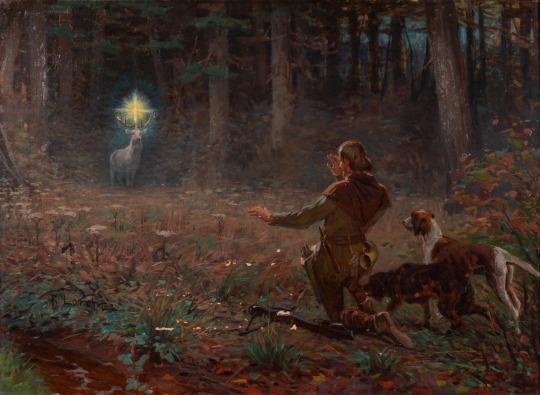
The Vision of St Hubert by Richard Lorenz
#st hubert#saint hubert#art#richard lorenz#vision#hunting#white stag#stag#deer#cross#crucifix#antlers#ardennes#forest#medieval#middle ages#christianity#christian#hounds#frankish#franks#france#belgium#germanic#history#europe#european#religion#religious#hubertus
2K notes
·
View notes
Note
hi what about the outsider from dishonored........if you would👀
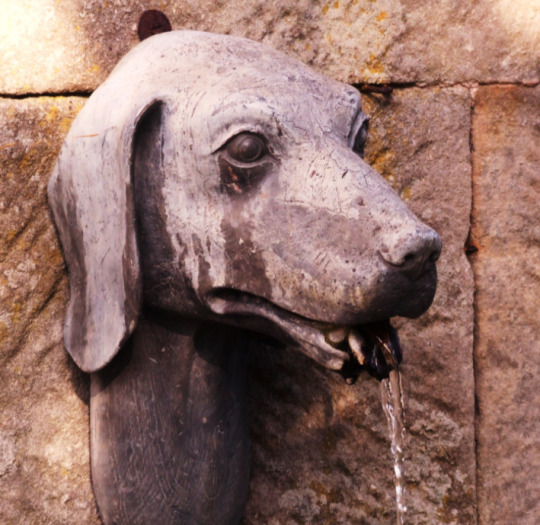

⭐️ The Outsider from Dishonoured is a Talbot Hound.
The Talbot (also known as the St. Hubert Hound) is a now extinct hunting hound bred in England during the Middle Ages. It is believed to be an ancestor of the modern Beagle and Bloodhound. It is uncertain whether it was a scent, sight, or quarry digging hound, nor is it known what quarry it hunted. If the Beagle and Bloodhound linage is to be believed, it was likely a scenthound, used to track game. The Talbot and the Greyhound were, apparently, the only hounds used in English heraldry, and it could be that the Talbot originated as an emblematic or heraldic hound. References to this heraldic Talbot seem to be earlier than any references to a real dog, but that seems to be because it was used as a blanket term rather than a true definitive breed. Some early dog-shows apparently offered classes for Talbots, but attracted no entrants, so they were dropped.
12 notes
·
View notes
Text
Frank Frayne’s Fatal Shot Echoed Through The Decades In Over-The-Rhine
When Frank I. Frayne’s troupe rolled into Cincinnati back in 1882, there was scant indication that he would precipitate the darkest night in Cincinnati theater history.
Frayne managed an immense production bankrolled by New York impresario Harry Miner. It was really big. Frayne’s show was so big, it was advertised as a “combination.” That was a term the biggest circuses used to describe their organizations. The “circus” meant only the acts in the sawdust ring. Add a sideshow with various freaks and a traveling zoo and you had a combination. That’s what Frank Frayne brought to Cincinnati. An advertisement [28 November 1881] gives a fair inventory of Frayne’s traveling ensemble:
“During the week and Wednesday and Saturday Matinees, Harry Miner’s Frank I. Frayne Combination and Dramatic Artists, and the Wonderful Acting Dog Jack, the African Lion Emperor; also the two Performing Bears Bruno and Chio. Monday, Tuesday, Wednesday and Wednesday Matinee, “Mardo, or, The Nihilists of St. Petersburg.” Thursday, Friday and Saturday and Saturday Matinee, “Si Slocum.”
One year later, in November 1882, Frayne was back in Cincinnati at the Coliseum Theater on Vine Street with the same two melodramas, but this time his menagerie was enlarged by the addition of a small pack of hyenas. Jack the Dog still got star billing. The Coliseum Theater up on Vine Street was the jewel in Hubert Heuck’s chain of theaters here and in various Midwest cities. It was formerly a beer garden but Heuck converted it into a theater and opera house at no small expense.
It appears that “Mardo” was Frayne’s personal adaptation of a play by Oscar Wilde, “Vera, or The Nihilists.” Frayne’s script has not survived, but the newspaper reviews suggest that it was a ton more exciting than Wilde’s drama. Here is the Enquirer [28 November 1882]:
“There are any amount of desperate actions, dastardly threats, fire scenes, murders, &c., and the lovers of this style of drama will see almost a lifetime of sensation in each act of “Mardo.” The dog Jack is a show in himself and acts his part with the best of the cast. During the play we see the Nubian lion, the ferocious hyenas and the wrestling bear, and these, together with a very passable cast, make it impossible for “Mardo” to be at all dull.”
Frank Frayne himself was fairly well known. He was a sharpshooter at a time when that was a popular stage act. Among his contemporaries and competitors were Annie Oakley and her mentor and husband, Frank Butler. Frayne found enormous success incorporating his rifle tricks into the context of various melodramas in which he portrayed heroic men of action forced to shoot their way out of diabolical predicaments.
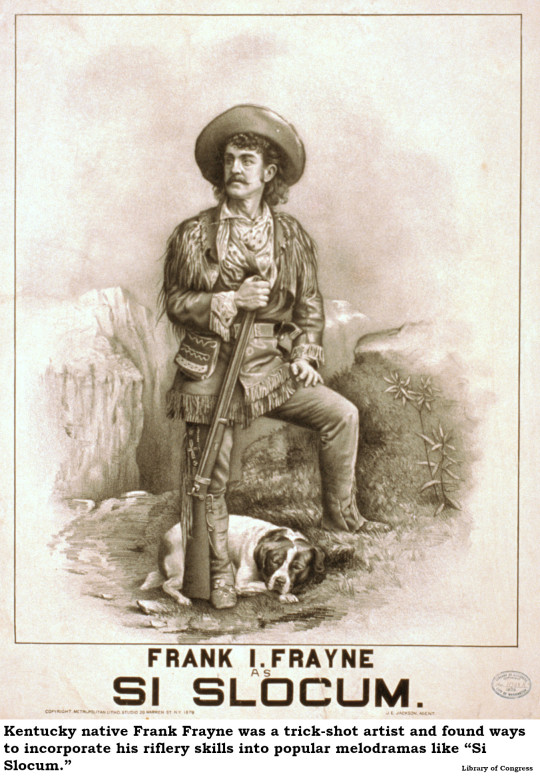
Frayne’s second Cincinnati offering, “Si Slocum” was written especially for Frayne by Clifton Tayleure, a successful Broadway producer. The plot is inconsequential, but involves Frayne as Si Slocum, a poor but honest rancher whose lands are coveted by the nefarious scoundrel, Vasquez. It is doubtful that Tayleure envisioned all the zoological extravagances and sharpshooting folderol Frayne piled onto his script. In the course of five acts, Slocum kills a lion, gets rescued by his faithful hound, shoots a pipe out of a ranch-hand’s mouth, plugs a half-dozen playing cards, shoots a bear, scatters the stage with random crockery and saves his wife several times. Somehow, the hyenas made an appearance as well. This stuff sold tickets back then. The Coliseum’s 2,000 seats were occupied the entire week of Frayne’s residency.
The role of Slocum’s wife was played by 25-year-old Annie Von Behren, an up-and-coming actress who was at that time Frayne’s fiancée. Brooklyn-born Miss Von Behren had an extensive theatrical resume before she took on the role of Ruth Slocum. She was thoroughly familiar with the Coliseum Theater, having performed for a couple of years among the stock company of that venue. She later joined a traveling troupe that took her to New York, where she met the widowed Frank Frayne, joined his combination as leading lady and won his heart.
At a critical scene in “Si Slocum,” Vasquez has Slocum cornered, with a dozen bandits drawing a bead on him. Vasquez announces that he likes Slocum’s “pluck,” and offers to free Slocum and end their feud if Slocum can shoot an apple off his wife’s head, while facing backward and aiming the shot with a mirror. Frayne had performed this trick shot hundreds of times over the years.
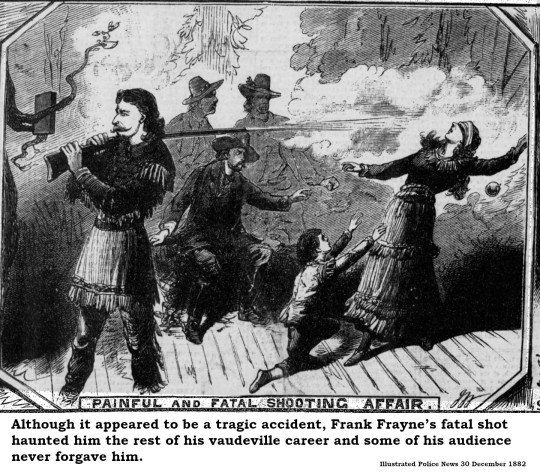
For reasons never fully explained, Frayne’s trick shot failed, and he sent a bullet through Annie Von Behren’s brain. Frayne screamed in terror as he rushed to his fiancée’s side. The curtain dropped immediately as the audience sat in petrified silence. Theater manager James Fennessey sent H.M. Markham, the actor appearing as the villain Vasquez, to the front of the stage to calm the audience. Markham nervously informed the crowd that the dead Annie von Behren had sustained a slight injury and they should collect a refund on their way out the door.
The next day, Coroner John Rendigs conducted an inquest, at which Frayne appeared. Some witnesses claimed Frayne’s rifle malfunctioned and that, in particular, a screw broke as the gun fired, dropping the rifle barrel downward. Some suggested the cartridge was defective. Other witnesses questioned why Annie was not wearing a metal cap under her wig as she usually did. The coroner declared the death accidental, caused by a bullet fired without criminal intent. Frayne announced he would never return to the stage but did so within a year, reviving the role of Si Slocum. Soon after, he married a woman named Margaret Thompson, who wisely refused to go on stage in his act.
Another victim of the Frayne shooting was the Coliseum Theater itself. Robert Heuck, son of Coliseum owner Hubert Heuck, explained [Bulletin of the Historical and Philosophical Society of Ohio - Volume 20, No. 4, October 1962] that the theater had to be renamed as a result of public opinion.
“The court decision declaring [Frayne’s] innocence was not taken lightly by a great many people in Over-the-Rhine. The show was only closed November 30th and December 1st, however; the receipts for the 2nd and 3rd were light. The court decision was so unpopular that it was thought best to change the name of this new theatre. In fact, it was called just that, "New Theatre," for some time. In 1883, the name of the New Theatre between 12th and 13th on Vine was changed to Heuck's Opera House, and the former Heuck's Opera House at 13th and Vine was re-named ‘People's.’ Of course, it's confusing! Many accounts relating to actors and plays of those earlier show days are in error for lack of understanding of this gobble-de-gook.”
The rechristened Heuck’s was renamed again in 1930 when it became a movie theater known as the Rialto. The building was demolished and the site is today a parking lot.
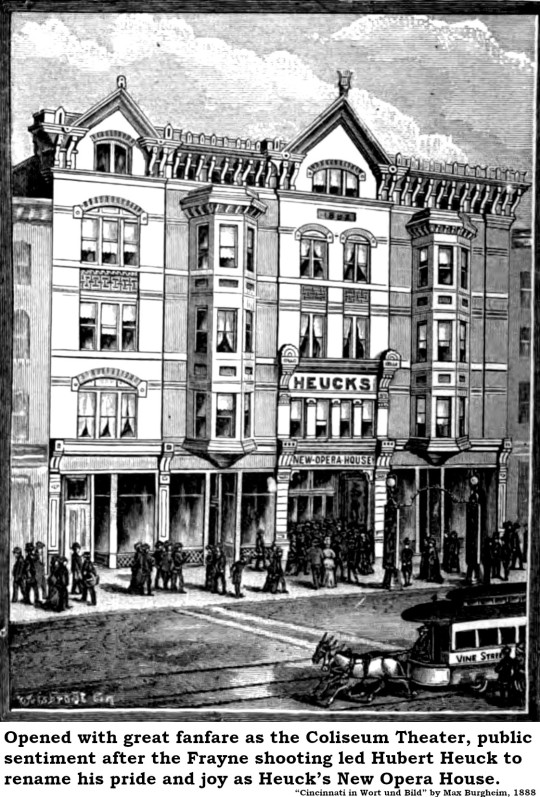
7 notes
·
View notes
Text
Die erstaunliche Welt des Bloodhounds: Alles über ihre ausgeprägten Geruchssinne
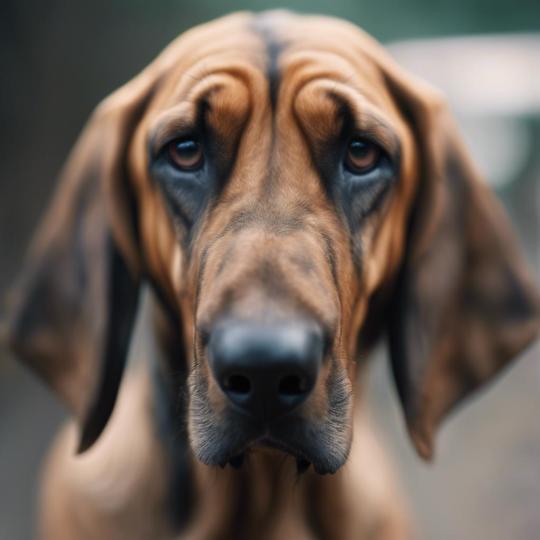
Der Bloodhound, auch bekannt als Bluthund, ist eine faszinierende Hunderasse, die für ihre ausgeprägten Geruchssinne und ihre beeindruckende Fähigkeit, Spuren zu verfolgen, bekannt ist. In diesem Artikel tauchen wir ein in die erstaunliche Welt der Bloodhounds und erfahren alles über ihre bemerkenswerten Eigenschaften und Fähigkeiten. Von ihrer Geschichte bis hin zu ihrer Verwendung in der Jagd und bei Rettungsaktionen, wir beleuchten alle Facetten dieser beeindruckenden Hunde. Die erstaunliche Geruchssinn des Bloodhounds Bloodhounds sind bekannt für ihren bemerkenswerten Geruchssinn, der sie zu erstklassigen Spürhunden macht. Ihre Fähigkeit, Gerüche aufzunehmen und zu verfolgen, ist außergewöhnlich und hat sie zu unentbehrlichen Hunden in verschiedenen Bereichen gemacht. In diesem Abschnitt werden wir genauer darauf eingehen, warum der Geruchssinn des Bloodhounds so beeindruckend ist und wie er zu ihren herausragenden Fähigkeiten beiträgt. Erklärung der Fähigkeiten des Geruchssinns des Bloodhounds Bloodhounds gehören zu den Hunden mit einem der besten Geruchssinne überhaupt. Sie sind in der Lage, selbst schwache Gerüche zu erschnüffeln und über große Entfernungen zu verfolgen. Diese Fähigkeit macht sie zu bevorzugten Spürhunden in verschiedenen Bereichen wie der Jagd, der Suche und Rettung, sowie auch in der Forensik. Physikalische Merkmale, die zum ausgeprägten Geruchssinn beitragen Die physikalischen Merkmale des Bloodhounds tragen wesentlich zu ihrem ausgeprägten Geruchssinn bei. Ihre großen, schlaffen Ohren helfen dabei, Gerüche besser aufzufangen, während ihre lange Nase mit Millionen von Riechzellen ausgestattet ist, die ihnen das Erschnüffeln von Gerüchen über weite Entfernungen ermöglichen. Wie weit kann ein Bloodhound riechen? Ein Bloodhound kann Gerüche über erstaunlich weite Entfernungen wahrnehmen. Es wird angenommen, dass sie Gerüche bis zu mehreren Kilometern entfernt erschnüffeln können. Diese Fähigkeit macht sie zu unschätzbaren Helfern bei der Suche nach vermissten Personen oder bei der Aufklärung von Verbrechen. Wie lange kann ein Bloodhound eine Duftspur verfolgen? Bloodhounds sind auch dafür bekannt, dass sie Duftspuren über lange Zeit hinweg verfolgen können. Sie sind in der Lage, einer Spur auch noch Stunden oder sogar Tage später zu folgen, was sie zu idealen Spürhunden in verschiedenen Einsatzgebieten macht. Ursprünge des Bloodhounds und Entwicklung des starken Geruchssinns Der Bloodhound, auch als St. Hubert Hound bekannt, ist eine der ältesten Hunderassen der Welt. Seine Geschichte reicht bis ins 7. Jahrhundert zurück, als Mönche im belgischen St. Hubertus-Kloster begannen, diese Hunde zu züchten. Durch gezielte Selektion wurde der ausgeprägte Geruchssinn des Bloodhounds über die Jahrhunderte hinweg entwickelt und verfeinert. Diese Hunde wurden ursprünglich für die Jagd auf Großwild wie Hirsche und Wildschweine eingesetzt und waren aufgrund ihres unübertroffenen Geruchssinns äußerst erfolgreich in dieser Aufgabe. Verfeinerung des Geruchssinns im Laufe der Jahrhunderte Im Laufe der Geschichte wurden Bloodhounds auch von den königlichen Familien Europas geschätzt und weiter gezüchtet. König Johann Ohneland von England führte die Hunde im 12. Jahrhundert in Großbritannien ein, wo sie bald einen Ruf als unschlagbare Spürhunde erlangten. Die gezielte Zucht auf den starken Geruchssinn führte dazu, dass der Bloodhound zu einem der effektivsten Suchhunde in der Geschichte wurde. Der Bloodhound wird oft mit der Lösung von Kriminalfällen in Verbindung gebracht, da er aufgrund seines außergewöhnlichen Geruchssinns in der Lage ist, selbst die schwierigsten Duftspuren zu verfolgen. Seine beeindruckende Fähigkeit, eine Fährte über weite Strecken zu verfolgen, hat ihn zu einem unverzichtbaren Werkzeug in der Kriminalistik gemacht. Der Bloodhound ist eine faszinierende Hunderasse mit einer reichen Geschichte und vielen interessanten Eigenschaften. In diesem Abschnitt werden wir einige lustige Fakten über den Bloodhound erkunden, die das Wesen und die Persönlichkeit dieser außergewöhnlichen Rasse näher beleuchten. Größe und Gewicht des Bloodhounds - Größe: Ein ausgewachsener Bloodhound kann eine stattliche Größe von bis zu 68-72 cm erreichen. - Gewicht: Das Gewicht eines durchschnittlichen Bloodhounds liegt zwischen 36-54 kg. Berühmte Hollywood Bloodhounds - Columbo: Ein berühmter Bloodhound, der in der beliebten TV-Serie "Columbo" als treuer Begleiter des Hauptcharakters diente. - Copper: Ein weiterer bekannter Bloodhound, der in Disney's "The Fox and the Hound" eine wichtige Rolle spielte. Temperament und Charakter des Bloodhounds - Sanftmütig: Bloodhounds gelten als sanftmütige und freundliche Hunde, die besonders liebevoll mit Kindern sind. - Geruchssinn: Ihr außergewöhnlicher Geruchssinn macht sie zu perfekten Jagdbegleitern und Duftdetektoren. Bloodhounds in Disney-Filmen - The Fox and the Hound: In diesem beliebten Disney-Film spielte ein Bloodhound eine Schlüsselrolle als treuer Freund des Fuchses. - 101 Dalmatians: Ein Bloodhound war auch in diesem Disney-Klassiker zu sehen, der die entzückenden Dalmatinerwelpen jagte. Bedeutung und Einsatzgebiete des Bloodhounds - Erstaunlicher Geruchssinn: Der Bloodhound verfügt über einen außergewöhnlichen Geruchssinn, der es ihm ermöglicht, selbst die schwächsten Duftspuren zu verfolgen. Diese Fähigkeit macht ihn zu einem unschätzbaren Helfer in verschiedenen Bereichen. - Rettungshund: Aufgrund seines bemerkenswerten Geruchssinns wird der Bloodhound oft als Rettungshund eingesetzt. Er kann vermisste Personen aufspüren, selbst wenn sie sich in unzugänglichem Gelände befinden. - Kriminalistik: Bloodhounds werden auch in der Kriminalistik eingesetzt, um vermisste Personen zu finden oder bei der Aufklärung von Verbrechen zu helfen. Ihr Geruchssinn ist so präzise, dass sie selbst nach Tagen noch eine Duftspur verfolgen können. Vergleich mit anderen Hunderassen Im Vergleich zu anderen Hunderassen zeichnen sich Bloodhounds vor allem durch ihren unglaublichen Geruchssinn aus. Während viele Hunde einen guten Geruchssinn haben, ist der Bloodhound in dieser Hinsicht unübertroffen. Seine Fähigkeit, selbst die schwächsten Duftspuren zu erkennen, macht ihn zu einem der besten Spürhunde der Welt. Wichtige Rolle des Bloodhounds in der Kriminalistik und Jagd - Spürhund: Der Bloodhound wird oft als Spürhund eingesetzt, um vermisste Personen aufzuspüren oder verlorene Gegenstände zu finden. Sein exzellenter Geruchssinn macht ihn zu einem unschätzbaren Partner für Polizei- und Rettungsteams. - Jagdhund: Ursprünglich wurden Bloodhounds als Jagdhunde gezüchtet und sind auch heute noch in dieser Rolle aktiv. Ihr ausgezeichneter Geruchssinn macht sie zu effektiven Jagdhunden, die Wildtiere aufspüren und jagen können. Zusammenfassung der herausragenden Fähigkeiten des Bloodhounds Der Bloodhound ist zweifellos eine der bemerkenswertesten Hunderassen, wenn es um den Geruchssinn geht. Mit ihrer Fähigkeit, selbst die schwächsten Duftspuren zu verfolgen, haben sie sich einen Ruf als unschlagbare Spürhunde erarbeitet. Ihr Geruchssinn ist so ausgeprägt, dass sie sogar in der Lage sind, individuelle Gerüche zu unterscheiden und über weite Entfernungen zu verfolgen. Bedeutung des Bloodhounds als zuverlässiger Duftdetektor In vielen Bereichen des Lebens finden Bloodhounds Verwendung als zuverlässige Duftdetektoren. Von der Suche nach vermissten Personen bis hin zur Aufklärung von Verbrechen leisten sie einen unschätzbaren Beitrag zur Gesellschaft. Ihre Fähigkeit, einem Geruch zu folgen und ihn über lange Strecken zu verfolgen, macht sie zu unverzichtbaren Helfern in zahlreichen Einsätzen. Insgesamt ist der Bloodhound ein faszinierender Hund mit unglaublich ausgeprägten Geruchssinnen. Ihr erstaunliches Talent, Verbrecher aufzuspüren und Menschenleben zu retten, macht sie zu einer der beeindruckendsten Hunderassen der Welt. Mit ihrem sanften Wesen und ihrer Treue sind Bloodhounds auch wunderbare Familienhunde. Wenn Sie sich also für einen Hund mit bemerkenswerten Fähigkeiten interessieren, könnte der Bloodhound die perfekte Wahl für Sie sein. Erforschen Sie weiter die Welt dieses faszinierenden Hundes und lassen Sie sich von seiner erstaunlichen Intelligenz und Fähigkeit, Gerüche zu verfolgen, begeistern. Lesen Sie den ganzen Artikel
0 notes
Text
Thank you for the link! I think I've read that one, but I look forward to finding out when I get home tonight. It certainly sounds like it does fit neatly into this conversation!
It's worth pointing out that the St Hubert's Hound which became the modern English bloodhound is a very different dog from the Cuban bloodhound, both then and today. That being said, the shared names created a very distinct influence on bloodhounds in horror in particular, and you're very correct that bloodhounds are still used for police work--though that's nearly all mantrailing / tracing human trails as opposed to being expected to actually catch humans without assistance. (Drug work is more typically done by either GSDs or gundogs, depending on how much of the potential for an intimidation factor a given police force wants from a dog.)
found this really cool article this morning about the history of the use of dogs to oppress BIPOC and particularly the use of the breed referred to variously as slave hounds and Cuban bloodhounds at the time, which was deliberately selected and trained as a weapon of terror. it's a horrifying history, but I think it's worth reading especially for American dog people as we face down a summer of police brutality that will come with the inevitable use of police dogs to perform the same terrorizing function—albeit with more in the way of fine grained, if often theoretical, control over the dog.
I still need to dig out sources to document the relationship between the Cuban Bloodhound and today's Fila Brasilero, because they are strong influences indeed. I am always thinking: what is the ethical underpinning of making the choice to preserve these dogs for the present day? Would it be better or worse to acknowledge their well documented history of colonial violence? We often keep dogs to preserve the parts of our culture and history we want to remember: what role does that play in the case of such a blood soaked, painful history of colonial terror?
Is the rebrand enough to justify keeping the dogs? How about breeds with Cuban bloodhound influence without being the modern form of the strain, such as Rhodesian Ridgebacks? How do the stories we tell about how dogs came to be help us form narratives about our own history?
596 notes
·
View notes
Link
[ad_1] A dog originally from Vermont is now up for adoption in New Jersey after he was relocated last month. Lionell is a two-year-old hound dog mix who is looking for a new home.He is currently available for adoption at the St. Hubert’s Animal Welfare Center in Madison, New Jersey. Lionell was transported to St. Hubert’s in July after intense rainstorms caused major flooding in Vermont. NEW JERSEY DOG WITH ‘BOUNDLESS ENERGY’ IS LOOKING FOR HER FOREVER HOME: MEET LAYLAThe flash flooding in Vermont left impacts not seen since Hurricane Irene in 2011, according to the National Weather Service. Windham County Humane Society in Brattleboro, Vermont, closely watched the nearby river — and was ready to evacuate its pets if necessary. Lionell is a 2-year-old hound mix originally from Vermont. He's now in New Jersey, awaiting a forever home. (St. Hubert’s Animal Welfare Center)Eventually, the shelter decided to relocate the 15 cats and three dogs living at the shelter in preparation for the potential influx of misplaced animals from the flood. NEW JERSEY DOG WITH A ROUGH START TO LIFE IS UP FOR ADOPTION: MEET CHIEF, THE THREE-LEGGED CHAMPLionell ended up in New Jersey. Since arriving there, Lionell has won the hearts of the staff members at St. Hubert’s. The pup was transported from Vermont to New Jersey after flooding in Vermont threatened shelter space. (St. Hubert’s Animal Welfare Center.)St. Hubert’s told Fox New Digital that he is a "total love bug" who will always pick cuddles with humans over toys. He really loves to snuggle and will happily lie in your lap — if you let him, the group said. Lionell is known to enjoy being active. He enjoys hiking and splashing around in the water.CLICK HERE TO SIGN UP FOR OUR LIFESTYLE NEWSLETTERSt. Hubert’s said Lionell has lots of puppy energy, so the group suggests he'd be a good fit for an active person or family. Lionell is known for being a very loving pup who has loads of energy. (St. Hubert’s Animal Welfare Center)St. Hubert’s Animal Welfare Center has a transport program with more than 90 other shelters; they regularly help those that might be struggling with overcrowding. Interested in adopting Lionell or other animals from the shelter?CLICK HERE TO GET THE FOX NEWS APPVisit St. Hubert’s website, sthuberts.org, for more information. Want to read about other pets up for adoption? Check out this recent article from Fox News Digital: Dog abandoned at the front door of animal care center is up for adoption: Meet Laa-LaaAnd click here for other Fox News Digital Adoptable Pets stories. Brittany Kasko is a lifestyle production assistant with Fox News Digital. [ad_2]
0 notes
Text
May I introduce you to bloodhounds (also called St. Hubert hound)
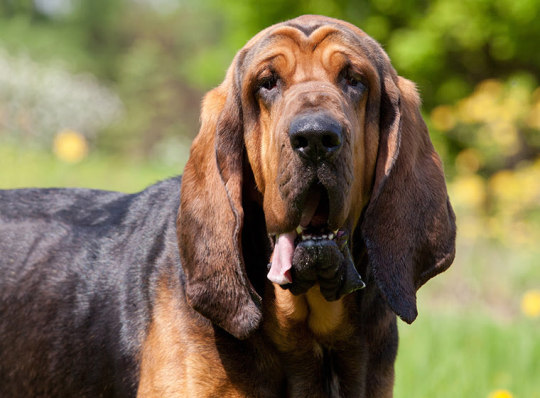
#yep#that's my new nickname#my crush came up with it because I dared to remind him that we needed to go somewhere#it's funny tho#and I'm carrying it happily#bloodhound#st hubert hound#dog#cute dog#wrinkly dog#cute
3 notes
·
View notes
Text
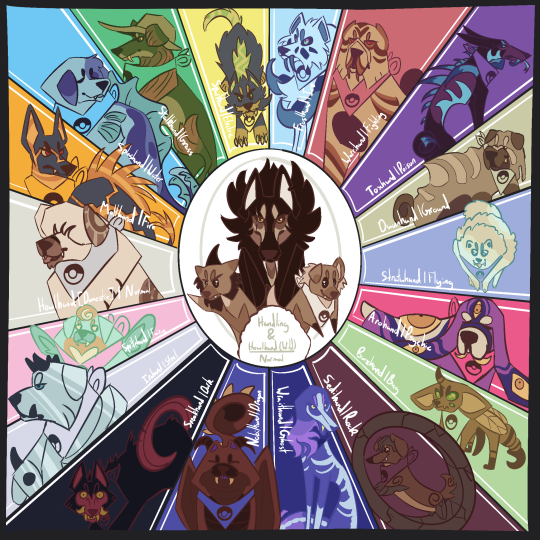

My very own Fakemon! It’s a dog Pokemon that evolves into a different type based on its Father’s primary type! You catch a Wild Hundling, it will evolve into a Wild Howlhund, but breed it with any Pokémon and it’s offspring will have an evolution based on the type!
Hundling (Wild and Domestic)- Normal (Based on Wolf Puppies)
Howlhund (Wild)- Normal (Based on Wolves)
Howlhund (Domestic)- Normal (Based on Old English Sheepdogs)
Molthund- Fire (Based on Xoloitzcuintlis)
Splashund- Water (Based on St. John’s Water Dogs)
Stalkhund- Grass (Based on Collies)
Sparkhund- Electric (Based on Cairn Terriers)
Frosthund- Ice (Based on Huskies)
Warrihund- Fighting (Based on Bully Kuttas)
Toxhund- Poison (Based on Tesems)
Duunhund- Ground (Based on Shar Peis)
Stratuhund- Flying (Based on German Spitzes)
Arohund- Psychic (Based on Saint Hubert Hounds)
Buzhund- Bug (Based on Chihuahuas)
Sedihund- Rock (Based on Turnspit Dogs)
Wraithund- Ghost (Based on Salukis)
Nobilhund- Dragon (Based on Chow Chows)
Sneakhund- Dark (Based on Kai Kens)
Irohund- Steel (Based on Malossus)
Spritehund- Fairy (Based on Japanese Chins)
#my art#drawing#pokemon#fakemon#old english sheepdog#wolf#xoloitzcuintle#Saint John’s water dog#collie#cairn terrier#Siberian Husky#bully kutta#tesem#shar pei#German Spitz#Saint Hubert hound#Chihuahua#Turnspit dog#saluki#chow chow#Kai Ken#molossus#Japanese chin#dog
61 notes
·
View notes
Text
me, writing: like a bloodhound he --- me: wait does this breed of dog even exist in the 1300s a helpful source: the St. Hubert hound was, according to legend, first bred ca. 1000 AD by monks at the Saint-Hubert Monastery in Belgium; its likely origins are in France, home of many of modern hounds. me:

#{ hell yeah hell yeah }#⚔️ // home was the daughter who could not be with us ( to be deleted )#⚔️ // i'm here i'm queer and lets get this meditation started ( mun )
6 notes
·
View notes
Photo

Year of the Dog - German Hound “The Bracke are an ancient type of hound. Their distinctive narrow heads and long ears set them apart from other types of hounds, and may show influence of the Greyhound or the ancient Celtic hounds. The St. Hubert's Hound (Bloodhound) may have contributed to the Bracke's voice, the distinctive call made by the dogs while chasing game. Over a very long period of time, Bracke developed into a variety of regional forms.
In 1896, the Deutschen Bracken Club, encompassing all of the local types of Bracke in northwest Germany, was formed in Olpe. The breeds were merged in 1900 as one breed and were officially designated Deutsche Bracke. This breed was formerly called by a variety of old regional names such as "Olpe Bracke", "Sauerländer Bracke" and "Westphalian Bracke", and other local types now blended into one breed. The only breeds of Bracke in the area today are the German Hound and the Westphalian Dachsbracke. The Westphalian Dachsbracke is a short-legged dog, possibly a cross of a Bracke with the Dachshund.
Hunting with the Bracke in early times was done with hunters on horses following the hounds, as done by the ancient Celts chasing deer, and modern-day fox hunters. Another sport, developed in the 16th century, did not require the expense of horses and big kennels, and made use of firearms, called Brackade. Hounds hunting this way tenaciously follow the game while voicing cries that communicate to the hunter as to where the dog is and what type of game the dog is following. Today, the Deutsche Bracke is usually used to hunt deer, but also rabbits and fox. Often, it is hunted singly as a leash hound, to hunt on smaller areas. The space needed to hunt a pack of hounds is described by the breed club as a minimum area of 1,000 ha (2471 acres). Related to the hunting with Bracke is the use of horns to communicate with the dogs, a custom that is continued today.”
On Redbubble!
You can support me on Patreon! Half the funds will go to a local no-kill shelter!
35 notes
·
View notes
Text
Bloodhound: Dog Breed, Origin, Health, Care Full Info
The Bloodhound’s ancestors were created in medieval France to track deer and boar. moment, this is a large active, and intelligent canine strain whose keen sense of smell has set up a special place in law enforcement and hunt and deliverance. Their suckers love them for their sweet nature and unique appearance.
Although this is a thoroughbred canine, you may find them in the care of harbors or deliverance groups. Consider relinquishment if this is the strain for you.
For educated canine parents, you’d have a hard time trying to find a further tender and loving companion, so long as you don’t mind a bit of drool then or there. But beginners should guard against this strain’s notorious intransigence and perceptivity.
Bloodhounds need establishment, harmonious training, and plenitude of exercise. Meet the strain’s requirements, and you’ll be awarded a content and happy stylish friend for life.
DogTime recommends this big, commodious jalopy to give your big Bloodhound a place to rest and relax. You should also pick up this canine water bottle for any out-of-door adventures you have with your doggy !
Origin: France, Belgium, and United Kingdom
Height: 25 to 27 inches males and 23 to 25 inches bitches
Weight: 90 to 110 pounds males and 80 to 100 pounds bitches
LifeSpan: 10 to 12 years
Color: Red, black and tan, or liver and tan
Breed Characteristics
The world- notorious’ dick Hound’ does one thing better than any critter on earth find people who are lost or caching. An off-duty Bloodhound is among the canine area’s most amenable citizens, but he is grim and stubborn on a scent.
Bloodhounds are large, substantial tykes standing 23 to 27 elevation at the shoulder and importing up to 110 pounds. Their most notorious features are a long, wrinkled face with loose skin; huge, drooping cognizance; and warm, deep-set eyes that complete an expression of solemn quality.
cover colors can be black and tan, liver and tan, or red. important legs allow Bloodhounds to scent over long hauls of chastising terrain. As pack tykes, Bloodhounds enjoy company, including other tykes and kiddies. They’re easygoing, but their nose can occasionally lead them into trouble.

History
The bloodhound has a long and noble history. The strain was perfected in the 7th century. Hubert of Belgium and his monks.
Also, these tykes have constantly been associated with kingliness. William the Conqueror brought several bloodhounds with him when he arrived in England in 1066, and ultramodern bloodhounds are descended from those tykes.
Meanwhile, back in Belgium, St. Hubert’s friary continued to present the king of France with a brace of black and tan bloodhounds every time. Indeed moment, in the French-speaking corridor of Europe, these tykes are known as St. Hubert hounds.
originally bloodhounds were used to track deer and other games. By the 16th century, still, they also were used to track people. moment bloodhounds help with law enforcement as well as hunt-and-deliverance sweats.
Their capacities are so largely regarded that trails performed by proven tracking bloodhounds are permissible as substantiation in court.
0 notes
Text
Basset Hounds, From St. Hubert to Columbo
Basset Hounds, From St. Hubert to Columbo

View On WordPress
0 notes
Text
Dressage de chiens Braque de Weimar à Sanary sur mer dans le Var 83

10 leçons pour éduquer et dresser son Braque de Weimar facilement à Toulon, La Ciotat, La Seyne sur mer, Ollioules. Educateur canin, dresseur de chiens & comportementaliste canin à Saint-Cyr sur mer. Tarifs dressage chiens à Toulon 83
Prendre rendez-vous 06 56 72 29 85
Adopter et vivre avec un Braque de Weimar. Histoire, éducation, santé et comportement
Histoire de la race Braque de Weimar
Weimaraner, ou Weimar Hound, est un représentant très rare dans une cohorte de chiens de chasse. Ce chien aristocratique remonte vraisemblablement au Moyen Âge, bien que les normes de race d'aujourd'hui ne se soient développées qu'au tournant des XVIIIe et XIXe siècles.
Le Braque de Weimar appartient au groupe des héritiers de la Bracken européenne (ou continentale) - des chiens d'arrêt à poil court, qui sont depuis longtemps communs sur le continent européen et ont des caractéristiques similaires à la fois extérieures et de travail. Parmi ses proches parents, ce chien se distingue nettement par sa couleur grise originale aux teintes spectaculaires, qui rend populaire la version de sa relation de longue date avec les chiens dits de Saint-Louis (Chiens gris de St-Loi), un dont on trouve la description dans d'anciennes sources manuscrites de l'époque légendaire des Croisades. . Des chroniques remontant au XIIIe siècle racontent qu'à la cour du roi de France Louis IX, dit Saint Louis, des chiens gris argentés sont apparus en 1254, après son retour dans son pays natal d'un autre voyage en Orient.
Dans les sources littéraires médiévales, il y a des références au fait que ces chiens étaient originaires de Tartarie - c'est ainsi que les pays de langue latine appelaient le territoire qui s'étendait des frontières de l'Asie centrale à ses limites septentrionales. Peut-être que les animaux ont été présent��s à Louis par l'un des dirigeants asiatiques, avec qui le monarque français a décidé d'établir des liens en Palestine. La description la plus détaillée est contenue dans le Livre de la chasse, l'un des meilleurs traités médiévaux sur ce divertissement des rois et des aristocrates. Son auteur est le comte Gaston de Foix, l'un des commandants de la guerre de Cent Ans et un chasseur passionné.
À la fin du XIVe siècle, les chiens gris sont devenus très populaires parmi la noblesse française, car ils ont démontré d'excellentes qualités dans la chasse aux gros animaux - cerf, sanglier, ours. Plus tard, les chiens ont également montré des capacités remarquables pour chasser les renards, les lapins et aller chercher des oiseaux. À la suite de l'aristocratie française, cette merveilleuse race a été emportée par des personnes couronnées d'autres pays de l'Europe féodale, et après elles leurs vassaux. Sur les tapisseries médiévales et les peintures représentant des scènes de chasse, vous pouvez voir des meutes de chiens gris - aussi nobles que leurs propriétaires titrés. Ces animaux sont également représentés sur les toiles des maîtres du XVIIe siècle, par exemple dans les peintures du peintre flamand Anthony van Dyck.
Parmi les géniteurs possibles du Braque de Weimar figurent également les chiens de Saint-Hubert, élevés au début du Moyen Âge dans l'abbaye de Saint-Hubert (Belgique). Les animaux de cette race, aujourd'hui disparue, sont considérés comme les ancêtres de nombreux chiens modernes. Ils avaient une couleur différente, parmi laquelle il y avait aussi du gris.
En tant que race distincte, le Braque de Weimar a commencé à se former au début du 19ème siècle. Selon des informations non confirmées, le duc de Weimar Karl August a été l'initiateur de sa création. Selon la légende, dans ses possessions, Saxe-Weimar, à l'est de l'Allemagne moderne, le duc était engagé dans l'élevage d'une race universelle de chiens - robustes, rapides et possédant également les qualités d'un chien de compagnie. Soit dit en passant, dans ces endroits, le chien est généralement appelé le "Silver Ghost". Il a reçu un tel nom en raison de sa couleur, coulée en argent, de sa capacité à se faufiler rapidement et silencieusement dans les champs, en restant invisible pour les proies.
De nombreux cynologues modernes, reconnaissant que la race a été élevée dans les environs de Weimar, pensent que le grand-duc de Weimar n'a rien à voir avec son origine, et la légende de la relation du Braque de Weimar avec les chiens gris de Saint-Louis a commencé à être popularisé par les amateurs de la race à la fin du 19e siècle pour sa reconnaissance en tant que race distincte et indépendante. Le fait est que pendant longtemps le braque de Weimar a été considéré comme une variété grise du chien courant allemand à poil court ou un croisement entre de grands chiens allemands et des braques anglais. Apparemment, ces déclarations étaient justifiées, puisque lors d'une exposition à Berlin en 1880, ces chiens ont été classés comme métis, sans leur trouver de traits de race originaux. Selon certains rapports, le Burgos Hound, Hugenhund, Schweishund ont été impliqués dans d'autres activités d'élevage. travaux prévus, ainsi que de nombreuses publications d'histoires fascinantes sur l'ancienne origine noble de la race et sa relation avec les chiens royaux français ont fait leur travail, et en 1896, une commission de délégués de diverses sociétés de chasse allemandes a finalement nommé le Braque de Weimar une race indépendante. À ce jour, il est reconnu par toutes les organisations cynologiques éminentes.
En 1897, le club de chasse allemand Weimaraner a été fondé et pendant longtemps, cette race a été une sorte de privilège protégé au sein de l'aristocratie allemande. Au départ, seuls les membres du Club étaient autorisés à acheter un chien. Et s'il était extrêmement difficile d'acheter un Braque de Weimar même dans son pays natal, alors en dehors de l'Allemagne, c'était généralement impossible. Dans les années 20 du siècle dernier, l'intérêt pour les chiens gris de l'Ancien Monde s'est manifesté aux États-Unis, mais les premiers individus envoyés à l'étranger étaient auparavant stérilisés, ce qui rendait impossible leur élevage en Amérique. En 1929, le Club a accepté le premier étranger dans ses rangs - l'Américain Howard Knight, qui a réussi à convaincre ses collègues allemands de vendre plusieurs chiens reproducteurs pour l'élevage dans le Nouveau Monde. En 1941, il crée le Weimaraner Club of the USA et en devient le président. Dans les années 1950, les Weimaraners ont acquis une popularité incroyable, devenant les animaux de compagnie de personnalités telles que le président Eisenhower et la star de cinéma Grace Kelly. Plus tard, un intérêt public supplémentaire pour eux a été alimenté par le photographe et artiste William Wegman, lui-même, soit dit en passant, qui est devenu mondialement célèbre grâce à ses images réussies de ces chiens.
L'engouement de masse pour les braques de Weimar - tant aux États-Unis qu'en Europe - a conduit au fait qu'aujourd'hui ils sont de plus en plus considérés comme des chiens de compagnie, des animaux de compagnie, des participants à des expositions et des championnats prestigieux. Dans le même temps, les qualités de chasse de beaucoup d'entre eux sont très ordinaires. Cependant, un bon chien de travail peut être trouvé. Ils représentent principalement les lignées allemandes et américaines, puisqu'en Allemagne et aux USA les éleveurs privilégient encore les qualités de travail de l'animal.
Il n'y a pas si longtemps, certains éleveurs européens et leurs homologues américains se sont lancés dans l'élevage de Braques de Weimar bleus. Ces chiens se distinguent par leur couleur de pelage gris bleuté d'origine. Aujourd'hui, ils sont élevés principalement comme chiens de compagnie, bien que les qualités de travail des pointeurs bleus soient identiques aux capacités exceptionnelles de leurs homologues gris. En 2009, aux États-Unis, des passionnés ont créé un club spécialisé, et depuis lors, à dessein, mais jusqu'à présent sans succès, ils ont cherché à faire reconnaître les Braques de Weimar bleus et à leur donner le statut de race indépendante.
Apparences du Braque de Weimar
Le Braque de Weimar est un chien assez grand de carrure athlétique, musclé, franchement musclé. Chez les mâles, la hauteur au garrot peut aller de 59 à 70 cm, poids - de 30 à 40 kg. Les femelles, en règle générale, sont plus petites: leur taille est de 57 à 65 cm, leur poids est de 25 à 35 kg. Selon la norme, les limites extrêmes ne sont pas souhaitables.
Tête
La tête, vue de dessus, ayant un contour en forme de coin, est proportionnelle au corps. Le crâne est légèrement convexe, pas large, la protubérance occipitale est faiblement développée. Le front est divisé par un sillon ; lorsque le chien est tendu, la région frontale est couverte de plis. La ligne de transition du front au museau est lisse, à peine marquée. Le nez est droit, avec une bosse miniature au niveau du lobe. Le lobe lui-même, dépassant au-dessus de la mâchoire inférieure, est grand. Il est peint dans une couleur chair foncée, virant progressivement au gris plus près de l'arête du nez. Les lèvres sont retroussées, la supérieure recouvre la inférieure et pend un peu, formant de petits plis aux commissures de la bouche. Les bords des lèvres, le ciel, les gencives sont d'une couleur chair rosée unie.
Mâchoires et dents
Les mâchoires avec un ensemble complet de dents semblent impressionnantes, démontrant clairement la capacité du Braque de Weimar à tenir un gibier de taille décente lors de la récupération. Les canines supérieures et inférieures se rejoignent solidement en ciseaux. Les pommettes musclées et bien définies sont clairement exprimées.
Yeux
Arrondi, de taille moyenne, placé légèrement obliquement. Leurs coins extérieurs s'élèvent légèrement plus près des oreilles. La couleur des yeux des chiots est bleu azur, chez les chiens adultes - ambre, d'intensité et de tonalité variables: du clair au foncé. L'expression des yeux trahit l'intelligence et l'attention. Les paupières sont bien ajustées contre le globe oculaire, leur couleur peut être chair ou correspondre au ton du pelage.
Oreilles
Grandes, larges, arrondies aux extrémités et tombantes exactement aux commissures de la bouche. Réglez hautes. Chez un chien, qui est alerté par quelque chose, les oreilles se dressent à la base et se tournent vers l'avant.
Queue
Une queue forte et épaissie à la base est placée assez basse, ce qui n'est pas caractéristique de la plupart des races apparentées au Braque de Weimar.��Elle est densément couverte de poils et se rétrécit vers la pointe. Lorsque le chien est détendu et paisible, il la maintient abaissée et, lorsqu'il est alerte, la soulève à une position horizontale ou plus élevée.
Le pelage
La longueur du pelage définit deux variétés de race : poil court et poil long. Le premier se caractérise par une laine courte, mais pas autant que dans la plupart des races identiques, très épaisse, dure, lisse. Le sous-poil est très clairsemé voire inexistant.
Le Braque de Weimar à poil long est recouvert d'un pelage soyeux assez long, avec ou sans sous-poil. Le pelage peut être droit ou légèrement bouclé. Sur les côtés, sa longueur est de 3 à 5 cm, les poils de la partie inférieure du cou, du devant de la poitrine et de l'abdomen sont légèrement plus longs. Les membres sont décorés de franges et de "pantalons", la queue - de "franges". Des poils longs et fluides sont présents à la base des oreilles, des poils légers et soyeux bordant leurs pointes.
Couleur
La norme autorise trois variations dans la couleur du Braque de Weimar : gris argenté, gris clair, gris foncé (souris). Ils peuvent avoir des nuances claires, par exemple, le cuivre, montrer un subtil brunâtre. Le pelage sur la tête et les oreilles est généralement légèrement plus clair que sur le reste du corps. Des marques blanches miniatures sur la poitrine et les orteils sont acceptables. La présence d'autres taches, marques de bronzage est considérée comme un inconvénient. Certains individus peuvent avoir une bande sombre, "ceinture", le long de la colonne vertébrale. En couleur, elle contraste avec la couleur dominante de l'animal. Ces chiens ne sont utilisés dans l'élevage que s'ils ont des qualités de chasse exceptionnelles.
Personnalité du Braque de Weimar
Les braques de Weimar sont des chiens énergiques, joueurs et amicaux. Ils sont dévoués de manière désintéressée à la famille dans laquelle ils vivent et ont besoin d'un contact constant avec une personne. Garder ces animaux dans un chenil, comme les autres chiens de chasse, ne devrait pas l'être, car cela les fait souffrir. Les braques de Weimar endurent également la solitude à la maison et la compagnie d'un autre animal ne les soulage pas du désir d'être proche du propriétaire. Il convient de noter qu'un chien laissé à lui-même pendant longtemps peut paniquer, «casser» les meubles de l'appartement et même se blesser en tentant de s'échapper de la maison. Inquiet, le Braque de Weimar se met à aboyer, gémir, hurler et même creuser. Le chien ne se calmera que lorsque le propriétaire apparaîtra sur le seuil. Ces animaux de compagnie adorent suivre leurs propriétaires bien-aimés, adorent s'asseoir à leurs pieds et avoir des «conversations» avec eux, ce à quoi ils sont très enclins. Le Braque de Weimar est un chien assez équilibré. Il se méfie des étrangers, mais ne fait pas preuve d'agressivité s'il est sûr que ses maîtres ne sont pas en danger. En raison de sa méfiance envers les étrangers, de son attention, de son esprit vif, de sa capacité à aboyer à tous les bruits et bruissements suspects à l'extérieur des portes, le chien peut devenir un bon gardien, mais le devoir de garde n'est clairement pas sa vocation.
Avec les enfants, surtout les plus âgés, ces chiens établissent des relations amicales et partenariales. Ils sont tolérants envers les enfants, mais, après avoir commencé un jeu avec ceux-ci, ils peuvent les blesser accidentellement.
Les braques de Weimar sont amicaux avec les autres chiens, surtout s'ils ont grandi à côté d'eux, mais ils ont rarement de bonnes relations avec les chats. Si ce chien est toujours capable de supporter l'animal de compagnie du propriétaire vivant avec lui dans la même maison, alors le représentant de la tribu des chats qui a erré imprudemment sur son territoire ne sera certainement pas accueilli. En fait, tous les petits animaux, ainsi que les oiseaux, éveillent un instinct de chasse indomptable chez le Braque de Weimar, devenant ses victimes potentielles.
Pendant la traque, les Braque de Weimar se manifestent selon leur tempérament inné et leurs qualités personnelles. Il existe des chiens de chasse extrêmement obéissants, mais très souvent, il y a des individus complètement «imprudents» qui deviennent instantanément incontrôlables pendant le travail.
Caractéristiques du Braque de Weimar
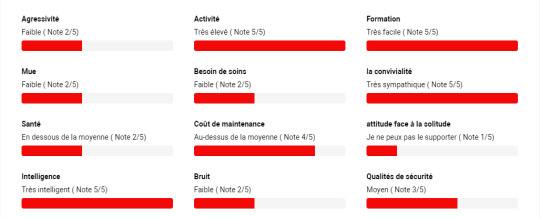
Éducation et formation du Braque de Weimar
Le Braque de Weimar est un chien extrêmement intelligent, attentif et compréhensif. Il se prête parfaitement à l'entraînement, mais, étant de mauvaise humeur, il peut faire preuve d'égarement et d'entêtement. Compte tenu de ces traits de caractère, le propriétaire doit faire preuve de fermeté et de patience dans l'élevage de l'animal. Il est nécessaire de former un animal de compagnie à l'obéissance dès son plus jeune âge, mais si l'autoritarisme dans l'éducation est acceptable, les méthodes qui incluent des cris grossiers et l'utilisation de la force physique comme punition doivent être exclues. La brutalité du propriétaire conduira au fait que le chien deviendra méfiant, les commandes seront exécutées de manière incertaine, avec prudence. Il sera très difficile de regagner la confiance du chien. Mais les friandises et les éloges stimuleront le Braque de Weimar à montrer ses meilleures qualités.
Lorsqu'il élève un chien acquis pour la chasse, le propriétaire doit trouver un terrain d'entente, car son obéissance inconditionnelle et son désir de plaire peuvent priver le chien de l'initiative dont il a besoin pendant le travail.
Santé et maladie du Braque de Weimar
Les Braques de Weimar forts et robustes se distinguent par une excellente santé, mais la prédisposition héréditaire à certaines maladies peut être un danger potentiel pour eux. Le tractus gastro-intestinal est à risque chez ces animaux, et une maladie comme le volvulus, caractéristique des chiens à poitrine profonde, peut leur être fatale. Après avoir remarqué les premiers signes d'indigestion chez votre animal, vous devez immédiatement contacter un vétérinaire qui lui prescrira un aliment diététique spécial. Habituellement, dans ces cas, il est recommandé au chien de se nourrir plusieurs fois par jour en petites portions. Pour éviter les volvulus, les experts conseillent de placer les plats contenant de la nourriture pour chiens sur une surface surélevée. Cela empêchera l'ingestion rapide de nourriture et l'entrée d'air dans l'estomac.
Les braques de Weimar sont sujets aux dermatoses et la maladie de von Willebrand, un trouble héréditaire de la coagulation sanguine, peut également les menacer. Ces chiens peuvent aussi avoir des problèmes ophtalmiques : atrophie cornéenne, torsion de la paupière, distichiasis - apparition d'une rangée supplémentaire de cils. Dans 24% des cas de décès prématuré d'un chien, le cancer en est la cause, principalement fibrosarcome, mastocytome, mélanome. Les braques de Weimar ont également une prédisposition à la dysplasie de la hanche et du coude.
Certains animaux de compagnie souffrent de troubles obsessionnels compulsifs - éprouvant de l'anxiété, les animaux commencent de temps en temps à sucer la literie et les couvertures.
Eleveurs de Braque de Weimar
https://www.uncompagnon.fr/fiche/4794/elevage-de-braque-de-weimar.html
https://www.domaineduneply.com/presentation?locale=fr
Standard du Braque de Weimar fiche FCI N° 99
Trouver un éducateur canin pour le Braque de Weimar près de chez vous
Nos Tarifs :
Tarifs éducation canine
Tarifs école du chiot
Tarifs pension canine
Tarifs Taxi animalier courtes distances
0 notes
Text
0 notes